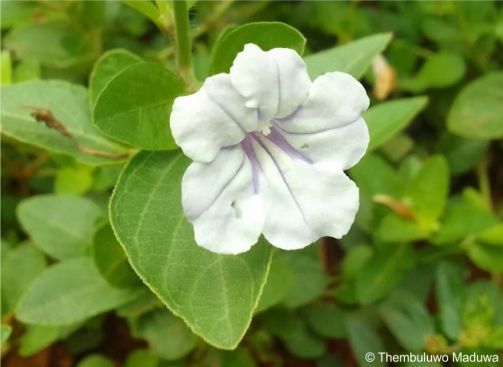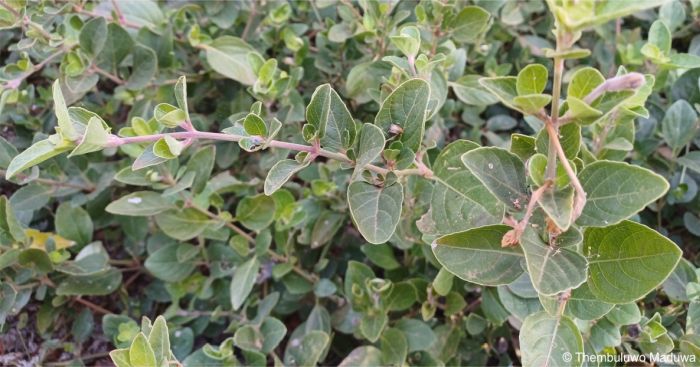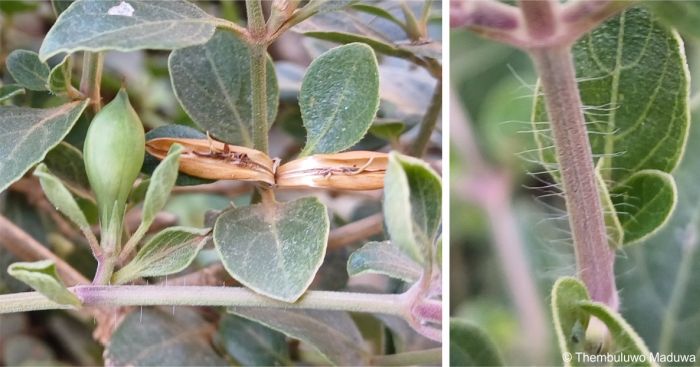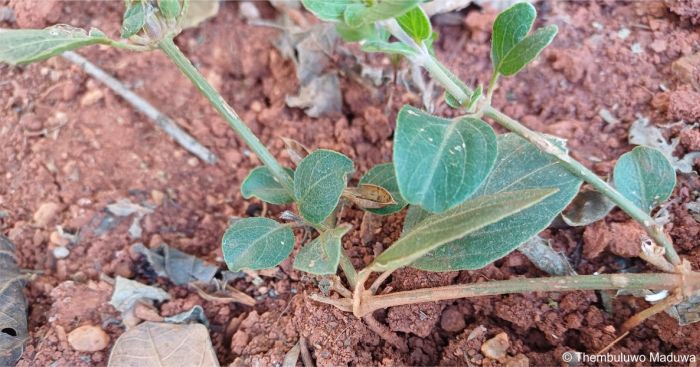Ruellia patula
Ruellia patula Jacq.
Family: Acanthaceae
Common names: white veld violet (Eng); witveldviooltjie (Afr.)
Introduction
A small attractive spreading perennial with stems up to 500 mm long, and white to mauve or purple funnel-shaped flowers in summer. It is easy to grow, adaptable, water-wise and low-maintenance, and thrives in sun or semi-shade.

Description
Description
Ruellia patula is a much-branched herbaceous shrublet, that produces new stems every year, arising from a woody rootstock. The stems can grow up to 500 mm long, are trailing to erect, almost hairless but hairy when they are still young, sometimes with stalked glands. The stems root at the nodes where they touch the ground. Leaves are opposite, 10-30 mm long, broadly ovate, on a petiole about 4-10 mm long. Flowers are produced in the axils of the leaves (axillary). The corolla is short-lived and falls early in the morning, white to mauve or purple. The fruit is a smooth capsule, containing about 8-11 seeds, green when still fresh and turning brown when they are fully matured. It opens and disperses the seeds on the ground once they are fully matured. Seeds are flat and brown. Flowering time is in early to mid summer, from November to January.

Conservation Status
Status
Ruellia patula is accessed as Least Concern (LC) according to Red List of South African plants. This means that the species does not have any threats.
Distribution and habitat
Distribution description
Ruellia patula occurs in South Africa and in tropical Africa, Arabia, Pakistan, India and Sri Lanka. In South Africa, it occurs in the provinces of Eastern Cape, Gauteng, KwaZulu-Natal, Limpopo, Mpumalanga and North West, growing in grassland, bushveld, riverine and woodland habitats. It is a low-maintenance, water-wise plant, and it can survive hot temperatures.

Derivation of name and historical aspects
History
The genus Ruellia is named after Jean de la Ruelle (1474-1537), a French botanist and physician. The species name patula is derived from Latin and means ‘open, spreading or extended’, which refers to the growth habitat.
Ruellia belongs in the Acanthaceae, a family that consists of about 250 genera and 2 500 species. The genus Ruellia contains about 360 accepted species that are spread through tropical America, Africa, Mascarene Islands, Asia and Australia, with 8 species found in South Africa. Ruellia is a large and widespread genus with many synonyms, and many are sometimes known by their former names, in particular, Dipteracanthus.
Ecology
Ecology
This species grows in a wide range of habitats, including grassland, bushveld, woodland, forest margin and in disturbed areas. It attracts bees and butterflies.

Uses
Use
Some species in the genus Ruellia, including Ruellia patula, are used in traditional medicine. The leaves are crushed into a paste which is used to treat several diseases, such as gonorrhea, syphilis, eye sores, poisonous bites, renal infection, kidney stones, toothache, diarrhea, constipation, flu, cough, asthma and high blood pressure.
Ruellia patula can be used as an ornamental plant for gardening and for landscaping. It makes a good groundcover in sun or semi-shade, and is suitable for containers and hanging baskets.

Growing Ruellia patula
Grow
This plant is easily propagated from seed and cuttings taken in spring.
Cuttings are taken in the morning when plant stems are full of water to prevent them from wilting or drying out. Make cuttings using a sharp, sterilized secateur, cut below a node, 10-15 cm long, and remove any leaves near the base and any flowers if they are present. Prepare the growing medium in a seedling tray, a mix of potting soil and washed river sand is recommended. Fill the seedling trays with the growing medium, make a small hole in which to plant the cutting, dip the base of the cutting into the powdered rooting hormone, insert the cutting stem into the hole and press to close the hole. Place the tray of cuttings in a warm area, not direct sunlight. Make sure that the growing medium is moist, be careful not to overwater since the cuttings will rot. Cuttings takes three weeks to root. To see if they have rooted check underneath the seedling tray by picking it up. Once the cuttings have rooted, they should be transplanted into plastic plant bags or pots, using the same growing medium that was used when propagating cuttings.
Sow seeds in spring or early summer, using a mixture of potting soil and washed river sand. Fill the seedling tray with the growing medium, settle and level the surface, and water well. Spread the seeds on top of the growing medium, spread them evenly and not too close to each other, cover the seeds with a light layer of the same growing medium. Place the seed tray in a warm area, not direct to sunlight, and water them. Seeds start to germinate after 10 days. Transplant your seedlings into a planting bag or pot after 2 months or as soon as they are large enough to handle, to promote the growth of the plant. Avoid leaving seedlings in the seedling tray for too long since it stunts the growth of the plant.
When planting in the garden, make sure that you harden off the young plant to prevent transplant shock, since it will be going from a protected nursery environment into direct sunlight. The best time to plant is summer. Make sure the young plants receive water until they are well established. When established. Ruellia patula can survive in dry areas, water requirement and maintenance are low.
Ruellia patula is attacked by white scale. This pest can be treated by spraying a suitable pesticide.
References
- Fabian, A. & Germishuizen, G. 1997. Wild flowers of northern South Africa. Fernwood Press, Vlaeberg.
- Hyde, M.A., Wursten, B.T., Ballings, P. & Coates Palgrave, M. 2024. Ruellia patula Jacq. Flora of Zimbabwe. Online. https://www.zimbabweflora.co.zw/speciesdata/species.php?species_id=153420. Accessed 2024/08/28.
- Kamundi, D.A. 2006. Ruellia patula Jacq. National Assessment: Red List of South African Plants. Accessed on 2024/09/02.
- Molokomme. N. 2021. Ruellia cordata Thunb. (Acanthaceae). PlantZAfrica. Online. https://pza.sanbi.org/ruellia-cordata.
- Plants of the World Online. Ruellia patula Jacq. https://powo.science.kew.org/taxon/urn:lsid:ipni.org:names:54401-1. Accessed on 2024/09/02.
- Samy, M.N., Sugimoto, S., Matsunami, K., Otsuka, H. & Kamel, M.S. 2015. Chemical constituents and biological activities of genus Ruellia. International Journal of Pharmacognosy 2(6): 270-79.
- Tripp, E.A. 2010. Taxonomic revision of Ruellia Section Chiropterophila (Acanthaceae): a lineage of rare and endemic species. Systematic Botany. 35(3): 629–661.
Credits
Thembuluwo Maduwa
Thohoyandou National Botanical Garden
October 2024
Plant Attributes:
Plant Type: Ground Cover, Perennial, Shrub
SA Distribution: Eastern Cape, Gauteng, KwaZulu-Natal, Limpopo, Mpumalanga, North West
Soil type: Sandy, Loam
Flowering season: Early Summer, Late Summer
PH:
Flower colour: Purple, White, Mauve/Lilac
Aspect: Full Sun
Gardening skill: Easy
Special Features:
Horticultural zones









Rate this article
Article well written and informative
Rate this plant
Is this an interesting plant?
Login to add your Comment
Back to topNot registered yet? Click here to register.